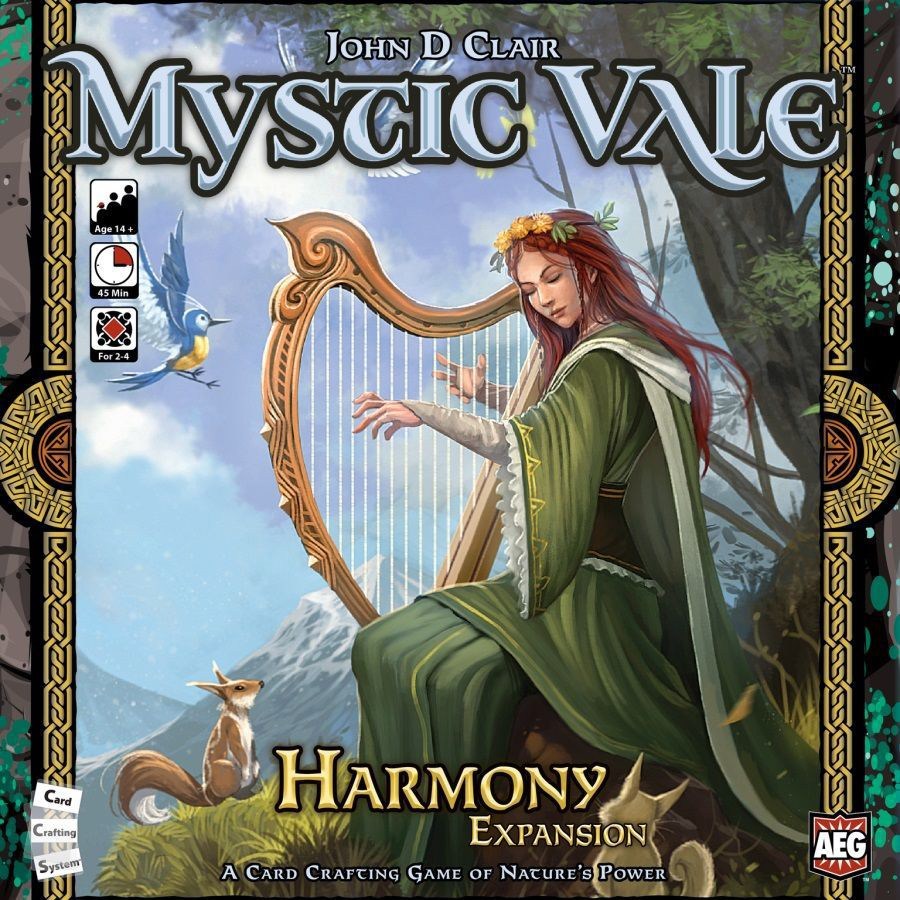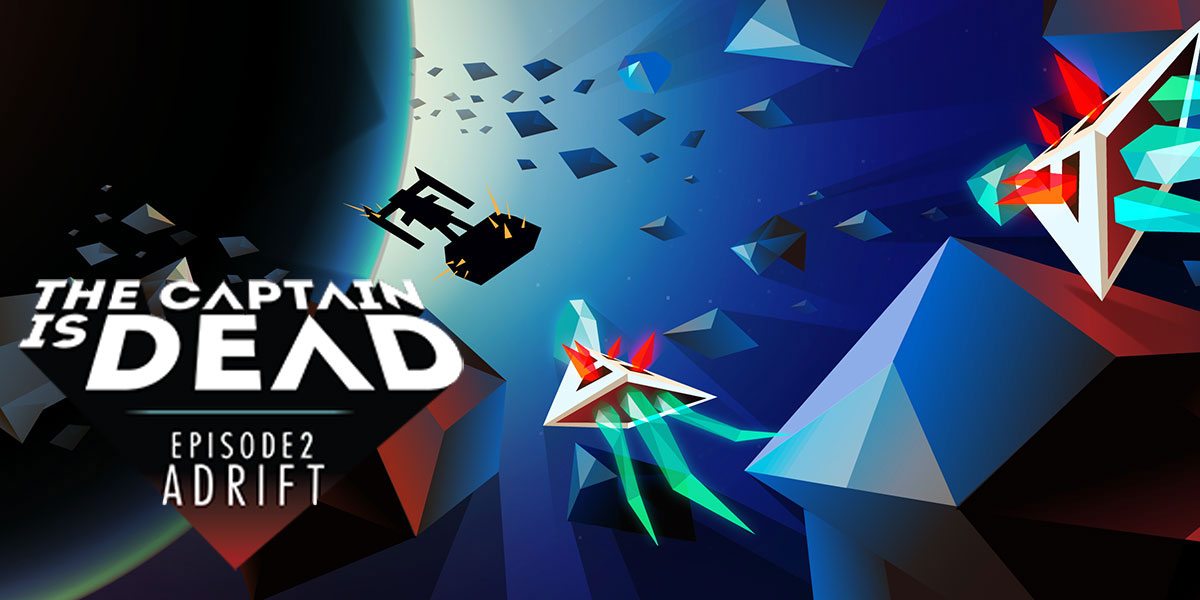Mystic Vale continues to grow, with new advancements, leaders, and amulets.
What Is Mystic Vale: Harmony?
Mystic Vale: Harmony is an expansion for Mystic Vale for 2 to 4 players, ages 14 and up, and takes about 45 minutes to play. The Mystic Vale base game is required to play. It retails for $39.99 and is in game stores now; you should be able to order directly from AEG’s website soon. As I mentioned in my review of the base game, I feel like the “14+” age rating could be lowered, particularly for kids who have some experience with deck-building games, because there isn’t really anything thematically inappropriate for younger players. I will note that games using the Harmony set may go a little bit longer—I’ll explain why in the verdict section of my review.

Mystic Vale: Harmony Components
- 105 Advancements
- 36 Vale Cards
- 8 Leader Cards
- 8 Amulets

How to Play Mystic Vale: Harmony
You can download a copy of the rulebook here.
Since this is an expansion to Mystic Vale, I won’t explain the base gameplay, but will just outline the new features of Harmony. If you’re not familiar with the base game, read my review here. Harmony includes a new set of advancements, leaders, and amulets, but does not introduce any new rule changes that haven’t been seen in other expansions.
Setup
During setup, deal each player 2 leader cards and let them choose one to use, returning the unused leaders to the box. Your leader card should be sleeved into one of your blank starting cards, with the cost to flip showing at the top right corner. You also give each player 2 amulets and let them choose one to keep, and one to return to the box. Amulets start with the black-and-white “Spoil” side face up.
There’s also an “official” setup where you deal several leaders and amulets out on the table, and take turns drafting them—each player picks one item in turn order, and then each player picks the other item in reverse turn order, until everyone has one leader and one amulet.
The rest of the setup is the same as the base game. Harmony includes enough advancements and vales that you can use cards entirely from Harmony for the setup, though you can also mix and match with the base game and other expansions as before.

Leader Cards
Leader cards were introduced in previous expansions, and give each player a different ability when the leader card is played. Any symbols present on the leader card work the same way as if they were present on an advancement card, but generally you may not put advancements onto the card with your leader.

During the Harvest phase, you may pay the mana cost shown at the top right corner to flip your leader card over, which usually gives it a more powerful ability the next time it is played. Some leader cards require you to flip them back to the starting side after they’re played, but most of them will stay on the flipped side after paying the cost. Also of note: leader cards have a point value at the bottom right of the card, and these may change when flipped.

Amulets
Amulets were first introduced in the Mana Storm expansion. Each player has one amulet, which replaces the mana token used in the base game. Whenever your field spoils, you flip over your token, just like before. However, instead of providing 1 mana to spend on a future turn, you now gain an ability that may be activated by evoking the amulet (and flipping it back to the Spoil side).

Each amulet has different abilities and states during what phases the ability may be used. For instance, the Blackwood Root Shard amulet, shown above, might prevent you from spoiling: you flip it in the air, and if it lands on the “spoil” side, then you gain 1 growth.
Some amulets have point values, which will be added to (or subtracted from) your score at the end of the game. There are also some card abilities that refer to “evoking” your token, which will apply whether you’re using the amulet tokens or the regular mana tokens—”evoking” simply means using it and flipping it back down.

Eclipse Cards
Eclipse advancements, first seen in the Vale of the Wild expansion, have the eclipse symbol in the lower left section of the illustration, showing two cards overlapping. The common feature is the vertical stripe, which might have some symbols or other abilities. Eclipse cards, unlike regular advancements, may have other advancements sleeved over them. Typically that would replace the eclipse advancement, but still retain the symbols or abilities on the vertical stripe (as long as the new advancement does not have its own stripe). Note that you may not sleeve an eclipse advancement over anything, including another eclipse advancement. Also, if you cover up an end-game points symbol, that symbol is no longer worth anything.

Legendary Advancements
Legendary advancements, first introduced in the Twilight Garden expansion, take up two slots on a card. Most function like regular advancements, but are expensive to buy and are quite powerful. Just as with usual advancements, you cannot typically cover up anything with either half of a legendary advancement, so you will be more limited in where you can place them.

For most of the advancements in the game, there are three copies, one each for the top, middle, and bottom slots. However, the legendary advancements are unique, and each legendary advancement has another unique single-slot advancement that pairs up with it, with only one copy. Also, each set also pairs up with a unique eclipse advancement that makes it even more powerful—if you can get them in the right order.

Why You Should Play Mystic Vale: Harmony
I’m still enjoying Mystic Vale and I always love to see what sorts of new effects are added to the game in each new expansion. (Eventually, maybe I’ll fill that massive Conclave box.) As mentioned earlier, this expansion is similar to Twilight Garden in that it has enough advancements that you can use it by itself—you still need the base game for the player decks, point tokens, and Fertile Soil advancements, but everything else is self-contained. It doesn’t add any totally new gameplay: the leaders, eclipse cards, amulets, and legendary advancements have all been introduced in other expansions before. However, if you have the base game and haven’t tried many of the other expansions yet, this is a set that includes all of those new additions in one place.

And, of course, the cards themselves are different, and it’s fun to figure out new combinations of card effects. I particularly like the way that the legendary advancements can be extremely powerful if you sleeve them over the corresponding eclipse advancement and pair them with the other single-slot advancement. There are only three combinations in this particular expansion, and I haven’t yet managed to build a card with any of them yet, but I’m going to keep trying.
I felt like a lot of the new advancements were about card manipulation: moving cards to the top or bottom of your deck, shuffling cards from your discard back into your deck, and so on. What I did notice, though, is that there seemed to be fewer cards that awarded point tokens. There aren’t any at all in the level 1 deck, and only one in the level 2 deck, so until you get to the point where you can afford level 3 advancements, you won’t be collecting any point tokens. That means, however, that the game may last longer, since the game end is triggered when the pool of tokens runs out.
The new amulets are also intriguing: a few of them allow you to manipulate your cards a little more, giving you a better chance to avoid spoiling. There’s an amulet that lets you swap amulets with another player, and a cursed one that gives you 3 bonus mana when you evoke it (but then gives you 1 fewer mana each turn when it’s on the spoil side). These have been fun to add into the mix.
I’m still learning the new leaders, too. One of my favorite names, though, is Sad Grumple and His Garden Patch. That leader starts the game with 6 vales, but loses one at random every time he is played—until you upgrade him. So the sooner you manage to upgrade him, the more of those vales you’ll get to keep.
With this many expansions, mixing together sets of advancements using the conclave cards (from the Conclave expansion) can be time-consuming and tedious, so I appreciate that the last couple of expansions can be played right out of the box, without mixing in anything else. It improves your odds of finding advancements and vales that work well together. However, if you want to play with 5 or 6 players using the equinox setup (also from Conclave), then you’ll need to decide which cards to mix into Harmony. Unfortunately, there aren’t new conclave cards provided for Harmony, and I’m not sure if AEG will be making a set of those in the future.
I’d recommend this particular expansion for those who want to try out some card manipulation powers, keeping in mind that it’s also a set that requires players (or at least one player) to build up to high mana counts before the game will end, since the point-harvesting advancements are mostly in the level 3 deck. You still have a few potential approaches for that: buying mana-rich cards, investing in growth so that you can play more cards without spoiling, and so on. As in Twilight Garden, there are also a few more cards that allow players to interact with each other, so if you want a little bit of increased player interaction, it’s also a good set to check out.
Find out more at AEG’s website!
Click here to see all our tabletop game reviews.
![]() To subscribe to GeekDad’s tabletop gaming coverage, please copy this link and add it to your RSS reader.
To subscribe to GeekDad’s tabletop gaming coverage, please copy this link and add it to your RSS reader.
Disclosure: GeekDad received a copy of this game for review purposes.






